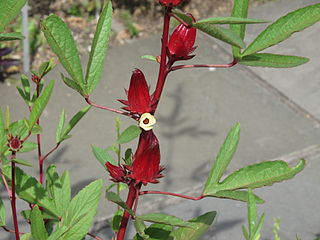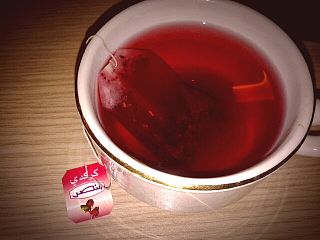
Sorrel, also called common sorrel or garden sorrel, is a perennial herbaceous plant in the family Polygonaceae. Other names for sorrel include spinach dock and narrow-leaved dock.

Hibiscus is a genus of flowering plants in the mallow family, Malvaceae. The genus is quite large, comprising several hundred species that are native to warm temperate, subtropical and tropical regions throughout the world. Member species are renowned for their large, showy flowers and those species are commonly known simply as "hibiscus", or less widely known as rose mallow. Other names include hardy hibiscus, rose of sharon, and tropical hibiscus.

Sambar is a lentil-based vegetable stew, cooked with pigeon pea and tamarind broth. It is originated from South Indian cuisine and now popular in large parts of India and beyond. The stew is similar to an other Burmese cuisine dish used as a popular accompaniment to Burmese curries. It has also been introduced into the culinary habits of Sri Lanka since the 20th century, among many other elements of South Indian cookery.

Roselle is a species of flowering plant in the genus Hibiscus that is native to Africa, most likely West Africa. In the 16th and early 17th centuries it was spread to Asia and the West Indies, where it has since become naturalized in many places. The stems are used for the production of bast fibre and the dried cranberry-tasting calyces are commonly steeped to make a popular infusion known by many names, including carcade.

Assamese cuisine is the cuisine of the Indian state of Assam. It is a style of cooking that is a confluence of cooking habits of the hills that favour fermentation and drying as forms of preservation and those from the plains that provide extremely wide variety of fresh vegetables and greens, and an abundance of fish and meat. Both are centred on the main ingredient — rice. It is a mixture of different indigenous styles with considerable regional variations and some external influences. The traditional way of cooking and the cuisine of Assam is very similar to South-East Asian countries such as Thailand, Burma (Myanmar) and others. The cuisine is characterized by very little use of spices, little cooking over fire, and strong flavours due mainly to the use of endemic exotic fruits and vegetables that are either fresh, dried or fermented. Fish is widely used, and birds like duck, pigeon, squab, etc. are very popular, which are often paired with a main vegetable or ingredient; beef used to be eaten before British colonialism, and some continue to do so. Preparations are rarely elaborate. The practice of bhuna, the gentle frying of spices before the addition of the main ingredients so common in Indian cooking, is absent in the cuisine of Assam. The preferred oil for cooking is the pungent mustard oil.

Tamil cuisine is a culinary style of Tamil people originating in the southern Indian state of Tamil Nadu and neighboring Sri Lanka. Meats, along with rice, legumes, and lentils, are also popular. Dairy products and tamarind are used to provide sour flavors. On special occasions, traditional Tamil dishes are served in a traditional manner, using banana leaves in place of utensils. After eating, the banana leaves are then used as a secondary food for cattle. A typical breakfast meal consists of idli or dosa with chutney. Lunch includes rice, sambar, curd, kuzhambu, and rasam.

Puran poli is an Indian sweet flatbread that popular in South India and the state of Maharashtra. It is also known as Puran puri, Holige, Obbattu, Bobbattlu, Poley, Bakshamulu, and Boli.

Odia cuisine is the cuisine of the Indian state of Odisha. Compared to other regional Indian cuisines, Odia cuisine uses less oil and is less spicy, while nonetheless remaining flavourful. Rice is the staple food of this region. Mustard oil is used in some dishes as the cooking medium, but ghee is preferred in temples. Odia foods traditionally served either on brass, bronze metal plates, banana leaf or disposable plates made of sal leaves.

Indian breads are a wide variety of flatbreads and crêpes which are an integral part of Indian cuisine. Their variation reflects the diversity of Indian culture and food habits.

Hibiscus tea is a herbal tea made as an infusion from crimson or deep magenta-colored calyces (sepals) of the roselle flower. It is consumed both hot and cold. It has a tart, cranberry-like flavor.

Pachadi refers to a traditional South Indian fresh pickle served as a side dish. Roughly translated, it refers to a plant which has been pounded or crushed.

Ragi mudde, ragi sangati or kali, colloquially simply referred to as either mudde or hittu which means 'lump' or 'dough' is a finger millet swallow dish of India in the state of Karnataka and Andhra Pradesh. In Tamil Nadu, especially in western Tamil Nadu, it is also called ragi kali. Ragi mudde is the main food in Kolar, Mandya, Hassan, Mysore, Tumkur districts in Karnataka and Rayalaseema Region in Andhra Pradesh. A similar variation known as Dhindo is also eaten in Northeast India, Nepal and Bhutan. In Uttarakhand and Himachal Pradesh in northern India, a similar variation is known as Baadi and Baari respectively.
Goan cuisine consists of regional foods popular in Goa, an Indian state located along India's west coast on the shore of the Arabian Sea. Rice, seafood, coconut, vegetables, meat, bread, pork and local spices are some of the main ingredients in Goan cuisine. Use of kokum and vinegar is another distinct feature. Goan food is considered incomplete without fish.

The culture of Andhra Pradesh embodies some very exclusive and special entities.

Andhra cuisine, culturally known as Telugu cuisine, is a cuisine of India native to the state of Andhra Pradesh and is the culinary style of Telugu people. It is generally known for its tangy, hot, and spicy taste.

Ambadi seed oil is extracted from seeds of the ambadi plant. It is an annual or perennial plant in the family Malvaceae and related to the roselle. It is believed to be native to Africa or Tropical Asia.

Telangana cuisine is the cuisine native to the Indian state of Telangana. The Telangana state lies on the Deccan plateau and its topography dictates more millets and roti based dishes. Jowar and Bajra features more prominently in their cuisine.

Roselle juice, known as bissap, wonjo, foléré, dabileni, tsobo, zobo, siiloo, soborodo or Sobolo in parts of Africa, sorrel in the Caribbean, and agua de Jamaica in Mexico, is a drink made out of the flowers of the roselle plant, a species of Hibiscus. Although generally the "juice" is sweetened and chilled, it is technically an infusion and when served hot can also be referred to as hibiscus tea.

Hibiscus leaves pickle is a popular pickle in Andhra Pradesh made with fresh Roselle or Gongura leaves, where it is known as Gongura pacchadi or Gongura Pickle. It is also consumed in Telangana, Tamil Nadu, Maharashtra, and Karnataka. In some of India's North-Eastern states, the plant is known as aamelli or mwitha. These sour/spicy pickles are also available commercially.



















